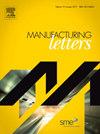Plasmonic image reproduction with solid-state superionic stamping (S4)
IF 1.9
Q3 ENGINEERING, MANUFACTURING
引用次数: 0
Abstract
Traditional top-down approaches for producing metallic nanostructures, despite being capable of producing arbitrary 2-D shapes, often use vacuum-based deep sub-micron lithographic fabrication technologies. This makes their use for single-use devices like chemical and bio-sensing substrates difficult to economically justify. Here, the authors demonstrate a manufacturing pathway that only uses such techniques to produce a master. This reusable master, coupled with a unique and facile electrochemical imprinting process, Solid-State Superionic Stamping (S4), is used to produce several replicated metallic nanostructures, thus demonstrating an economically feasible manufacturing pathway for single-use, nano-enabled devices.
This paper uses plasmonic image reproduction as an easy-to-visualize proxy for single-use devices such as plasmonic sensors and Surface Enhanced Raman Spectroscopy (SERS) substrates that require nanopatterned metallic structures. It demonstrates a process for replicating a picture by a set of metallic structures that plasmonically produce the desired colors locally. It uses a digitizing computational tool, direct-write Two-Photon Lithography (TPL) and a dry-etch process to rapidly produce a silicon master. This master is used to hot emboss nano-patterns in superionic glass blanks that, in turn, are used for electrochemical imprinting with S4 to reproduce the patterns on Ag substrates. The different steps in this process flow are described along with their role and effectiveness in contributing to a high-fidelity plasmonic image reproduction.
利用固态超离子冲压技术再现等离子图像 (S4)
生产金属纳米结构的传统自上而下方法尽管能够生产任意的二维形状,但通常使用真空深亚微米光刻制造技术。这就使得将其用于化学和生物传感基底等一次性设备在经济上难以成立。在此,作者展示了一种仅使用此类技术生产母版的制造途径。这种可重复使用的母版与独特而简便的电化学压印工艺--固态超负离子冲压(S4)--相结合,可用于生产多种复制的金属纳米结构,从而为一次性使用的纳米设备展示了一种经济可行的制造途径。本文将等离子图像复制作为一次性使用设备(如等离子传感器和表面增强拉曼光谱(SERS)基底)的一种易于可视化的代理方法,这些设备需要纳米图案化的金属结构。它展示了通过一组金属结构复制图片的过程,这些金属结构能在局部产生所需的颜色。它使用数字化计算工具、直接写入双光子光刻技术(TPL)和干蚀刻工艺来快速制作硅母版。该母版用于在超离子玻璃坯上热压印纳米图案,然后用 S4 进行电化学压印,在银基板上复制图案。本文介绍了这一工艺流程中的不同步骤,以及它们在高保真等离子图像再现中的作用和效果。
本文章由计算机程序翻译,如有差异,请以英文原文为准。
求助全文
约1分钟内获得全文
求助全文
来源期刊

Manufacturing Letters
Engineering-Industrial and Manufacturing Engineering
CiteScore
4.20
自引率
5.10%
发文量
192
审稿时长
60 days
 求助内容:
求助内容: 应助结果提醒方式:
应助结果提醒方式:


